RBSE Class 11 History Important Questions Chapter 1 From the Beginning of Time
Rajasthan Board RBSE Class 11 History Important Questions Chapter 1 From the Beginning of Time Important Questions and Answers.
Rajasthan Board RBSE Solutions for Class 11 History in Hindi Medium & English Medium are part of RBSE Solutions for Class 11. Students can also read RBSE Class 11 History Important Questions for exam preparation. Students can also go through RBSE Class 11 History Notes to understand and remember the concepts easily.
RBSE Class 11 History Important Questions Chapter 1 From the Beginning of Time
Very Short Answer Type Questions
Class 11 History Chapter 1 Important Questions And Answers Question 1.
Write any three sources which help us to know about the early human history.
Or
Which discoveries helped us to understand early human history ?
Answer:
The sources which help us to know or understand the early human history are:
(i) Fossils
(ii) Stone tools
(iii) Cave paintings.
Class 11 History Chapter 1 Extra Questions And Answers Question 2.
What are fossils?
Answer:
The remains of the old animal, human beings or old plants which have turned into solid forms i.e., stones are known as fossils.

Class 11 History Ch 1 Important Questions Question 3.
What do you know about primates?
Answer:
Primates are the subgroup of a large number of mammals. They include monkeys, apes and humAnswer:
Important Questions For Class 11 History Chapter 1 Question 4.
What are species?
Answer:
Species are the group of both male and female organism. They can breed together and gave birth to an offspring.
Source Based Questions History Class 11 Chapter 1 Question 5.
What do you know about Charles Darwin?
Answer:
Charles Darwin was bom in 1809. He was a famous English Scholar who wrote his book “On the Origin of Species” in 1859. He passed away in 1882.
History Class 11 Chapter 1 Important Questions Question 6.
What are Artefacts?
Answer:
Artefacts are the objects made by human beings. Tools, paintings, engravings, sculptures etc., are the examples of artefacts made by human beings.

Question 7.
Name a few places from where paintings depicting the pictures of animals have been found.
Answer:
Places from where paintings depicting the pictures of animals are :
(i) Caves of Lascaux and Chauvet, in France.
(ii) Altamira in Spain.
These include depictions of bison, horses, ibex, deer, lions, bears.
History Chapter 1 Class 11 Important Questions Question 8.
Where did Hominids originated?
Answer:
Hominids originated in Africa. There earliest evidence have been traced from eastern Africa.
Ch 1 History Class 11 Extra Questions And Answers Question 9.
Where do you find the earliest traces of Australopithecus ? Write any two characteristics about them.
Answer:
The earliest traces of Australopithecus have been found from Oduvai Gorge.
Characteristics of Australopithecus:
(i) They spent most of their time on trees.
(ii) They had big jaws and teeth.
Class 11 History Chapter 1 Questions And Answers Question 10.
Define the term ‘Homo’. How did scientists classify Homo ?
Answer:
The term ‘Homo’ is a Latin word which means ‘man’.
The scientists classified ‘Homo’ into three categories :
(i) Homo Habilis,
(ii) Homo Erectus,
(iii) Homo Sapiens.
History Class 11 Chapter 1 Question Answer Question 11.
Define ‘Homo’. Explain the main difference between Hominids and Hominoids.
Answer:
Homo is a Latin word which means ‘man’. Both males and females are included in it. Homo is further divided into branches like: Homo habilis, Homo Eerectus and Homo Sapiens.
Class 11 History Chapter 1 Short Questions And Answers Question 12.
Difference between Hominids and Hominoids.
Answer:
|
Hominids |
Hominoids |
|
1. They have larger brain size. |
1. They have a smaller brain. |
Chapter 1 History Class 11 Important Questions Question 13.
Mention two evidences which suggest an African origin for Hominoids.
Answer:
Two evidences which suggest an African origin for Hominoids are :
(a) Agroup of African apes is closely related to Hominoids.
(b) Early Hominoids have been found in East Africa dated back to 5.6 mya.

Class 11 History Ch 1 Extra Questions Question 14.
Write the period in which the man was a food producer.
Answer:
Man was a food producer in the neolithic age.
Important Questions Of History Class 11 Chapter 1 Question 15.
Hominids belong to which family?
Answer:
Hominids belong to a family which is known as Hominids.
History Class 11 Important Questions Question 16.
What is Ethnography?
Answer:
Ethnography is the study of the con-temporary ethnic groups. It also includes an examination of their modes of livelihood, technology, gender roles, rituals, social customs etc.
Class 11 History Short Question Answer Question 17.
Explain the term ‘Anthropoly
Answer:
Anthropoly is the study of human culture and evolutionary aspects of human biology.
Class 11 History Important Questions Question 18.
Who were Australopithecus ?
Answer:
The remains of the ape man who used to walk straight were known as Australopithecus. Their remains have been found in Africa.

Source Based Questions Class 11 History Question 19.
What do you know about Neanderthal Man?
Answer:
He was of short stature, broad chest, flat nose and head. His neck resembled with that of a bull. He used to buxy dead bodies. His remains have been found in Neander Valley in Germany.
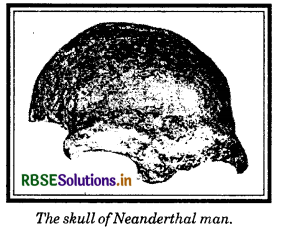
Class 11 History Most Important Questions Question 20.
Write any two characteristics of the Cro-Magnan Man.
Answer:
(i) This type of man belong to the species of Homo-sapines.
(ii) His body resembled to the modem man.
(iii) His remains have been found in France.
Class 11th History Chapter 1 Important Questions Question 21.
What are ‘Genus’ ? Name any two important genus of Hominids.
Answer:
Hominids are divided into different branches. These branches are known as genus. Two important genus of Hominids are:
(a) Homo
(b) Australopithecus.
Question 22.
How have the fossils of human beings been classified?
Answer:
The fossils of human beings have been classified into three categories :
(a) Homo habilis,
(b) Homo erectus,
(c) Homo sapiens.
From The Beginning Of Time Class 11 Question 23.
Where are Altamira caves ? What is its importance ?
Answer:
Altamira caves are located in Spain. The paintings on the ceiling of the caves were first brought into notice by an archaeologist, Marcelinosanz de Sautuola and his daughter Maria in November 1879. She brought these paintings to, the notice of his father. At first looking of the picture of oxen, he just laughed, but soon realised that some sort of paste rather than the paint has been used for paintings. Two decades later, his findings were dismissed by European archaeologists on the ground that they did not appear too good to be ancient.

Class 11 Chapter 1 History Important Questions Question 24.
Can you justify the statement, “The development of language proved benefit in the construction of house”.
Answer:
Yes, because
(i) It helped the man to communicate and discuss about secure places for construction of houses.
(ii) It also helped the earlyman to discuss the requisite for the construction of houses.
Class 11 History Chapter 1 Important Questions Question 25.
What do you know about Hadza people ?
Answer:
(a) Hadza were the group of people living in small groups in and around Lake Eyasi.
(b) They lived on hunting and gathering and never claim over the land.
(c) They were brought into limelight by James Woodbum in 1960.
Ch 1 History Class 11 Questions And Answers Question 26.
When did Ice-Age begin ? Write any two consequences of Ice Age.
Answer:
Ice Age begun in 2.5 mya.
(i) As a result of Ice Age temperature and rainfall decreased, which led to the decrease of forest cover on the earth.
(ii) It led to the extinction of Australopithecus about 1.3 mya.
Question 27.
Write in brief about the art in Palaeolithic Age.
Answer:
During Palaeolithic Age man lived in caves. To pass his free time he used to draw some beautiful designs and pictures on the walls and ceiling of the caves. These paintings (cave painting) depict their religious and social beliefs.
Question 28.
Where is Dolni Vestonice ? Why its well known ?
Answer:
Dolni Vestonice is situated in Czech Republic. Its known for its hunting sites.
Question 29.
What were the advantages of tool making for early man.
Answer:
Advantages :
(i) Woman parti- Clearly may have made and tool to obstain food for themselves and their children.
(ii) Tools might have helped them in removing flesh from the bones.
(iii) Tools would be helped them in drying and staring food for later consumption.
(iv) The introduce tion of the punch blade technique made possible the manufoture of the small chisel like tools. It made possible engravings on bone, antler, ivory or wood.
Question 30.
From where do we get the earliest evidence of making stone tools? Who were the earliest tool makers ?
Answer:
We get the earliest evidene for making tools from two sites :
(i) Ethiopia,
(ii) Kenya
Australopithecus were the earliest tool makers.

Question 31.
What are the various opinions regarding the development of language?
Answer:
Various views regarding the development of language are given below ;
(i) Hominid language including the symbols gestures and hand movements.
(ii) Spoken language came into being after humming (hominid language).
Short Answer Type Questions
Question 1.
Who were Hominids ? From where do we get their earliest evidence we get them ? Write any three features of these groups.
Answer:
Hominids evolved from Hominoids in about 5.6 mya. The earliest evidence we can get from Laetoli and Hadar. These evidences tell us that they originated in Africa. They were closely related to African monkey.
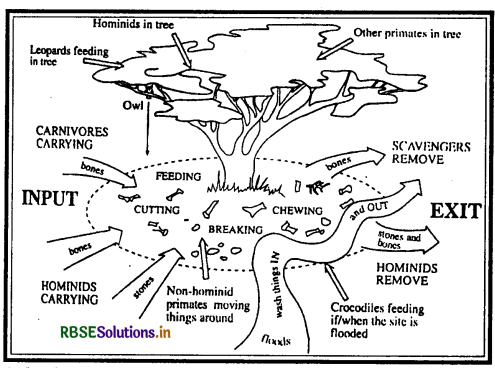
Their fossils have been also founded in Africa.
Features :
(i) They belong to Hominid family.
(ii) They had bigger brain and could walk erect and stand erect.
(iii) They were able to make tool with their hands.
Question 2.
Where were the fossils of Australopithecus found ? Write three features about them.
Answer:
The fossils of Australopithecus have been discovered from Olduvai Gorge by Mary and Louis Leakey. These fossils have been dated back to 5.6 mya.
Features of Australopithecus :
(i) Australopithecus could not stand in erect postures and spent most of his time on trees.
(ii) They had stronger jaws and bigger teeth.
(iii) They had smaller brain as compared to ape.
(iv) They begun to make tool for his protection.

Question 3.
How will you distinguish between Hominoids and monkeys ?
Answer:
(i) Hominoides had no tail like monkeys.
(ii) The Hominoide’s infant grow much slowly as compared to monkeys.
(iii) Monkeys have smaller body as compared to Hominoids. Hominoids have large body and waist.
(iv) Hominoids have longer period of infant dependency as compared to monkeys.
Question 4.
When did early human started dwelling in cave ? How did living in caves benefited him ?
Answer:
Early man began dwelling in caves about 400,000 years ago.
Dwelling in caves proved him very beneficial.
(i) It provide him natural shelter.
(ii) It provide him protection from wild animals.
(iii) He begun to live a settled life instead of wander from place to place.
Question 5.
How did the development of language prove advantageous in hunting ?
Answer:
The development of language advantageous for the early man (human being) in following ways :
(i) People could now organise and manage hunting expedition.
(ii) They could exchange ideas about the region where specific animals were found.
(iii) They could now discuss about the nature and behaviour of animals.
(iv) They could discuss how to consume the meat of animals.
(v) They could also discuss the nature of tools used in hunting.
Question 6.
Describe the progress made by early stone age man in respect of shelter, clothes, tools and weapons.
Answer:
Progress made by early stone age man in respect of shelter, clothes,tools and weapons is discussed under following heads :
(i) Shelter : Early stone age man lived on the branches of trees and naturally available caves. With the introduction of agriculture, he began to lead a settled life and domestication of animals.
(ii) Clothing: Early stone age man used bark of trees and leaves to cover his body.
(iii) Toojs and Weapons : Early man used tools and weapons made up of stones. He made these stone tools himself.
Question 7.
Differentiate between Australopithecus and Homo.
Answer:
|
Australopithecus |
Homo |
|
1.It is derived from a Latin word ‘austral’ meaning southern and a Greek word ‘pithekos’ meaning ape. |
1. It is a Latin word meaning ‘man’. Both males and females are included in it. |
|
2.They have a smaller brain. |
2. They have a larger brain. |
|
3. Heavier jaws and larger teeth enabled them to eat raw meat. |
3. Smaller jaws and inverted teeth enabled them to eat only soft meat. |
|
4. They are quadraped i.e., walk on four legs. |
4. They are bipedal i.e., walk on two legs. |
|
5. Limited use of hands did not allow them to make stone tools. |
5. More use of hands enabled them to make and use stone tools. |

Question 8.
What were the advantages of bipedalism to early humans ? From where do we get evidences of bipedalism.
Answer:
Bipedalism had the following advantages :
(a) It freed early human’s hands. Now he could use his hands for carrying infants or objects.
(b) As hands were used more and more, upright walking gradually became more efficient.
Except from the advantages of freeing hands for different uses, quite less energy was consumed while walking as compared to the walking as quadraped.
Evidences of bipedalism are recovered from
(a) Laetoli in Tanzania,
(b) Hadar in Ethiopia.
Question 9.
What do you know about early man’s tools and weapons which techniques were used to make these tools?
Answer:
Early man’s tools and weapons were made of stones. Stone tool makers were both men and women. Women in particular may have made and used tools to obtain food for themselves as well as to sustain their children after weaning. We get the earliest evidence for tool making from Kenya and Ethiopia. Techniques used for tool making were :
(a) Stone on Stone : In this technique, the pebble from which the tool was to be made was held in one hand and the second stone was used to strike off flakes from the first.
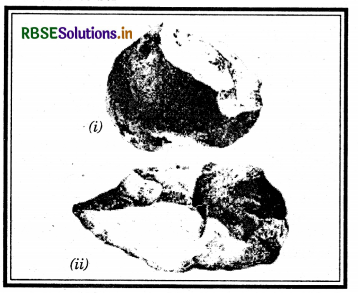
(i) The one above is a chopper. It is a large stone from which flakes have been removed to produce a working edge. The given
(ii) is a hand axe.
(b) Pressure Flaking : Here the core was placed in one hand on a firm surface. The hammer stone was used on a piece of bone or stone that was placed on the core to remove flakes that could be shaped into tools.
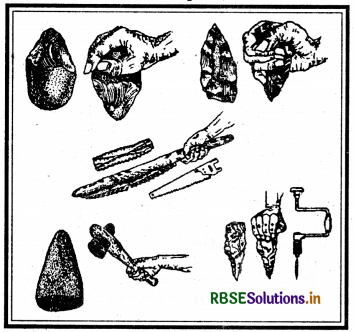
(c) Punch Blade Technique : In this technique, the top of a larger pebble was removed by using a hammer stone to produce a flat surface. This flat surface, thus so produced, is called striking platform. This is then struck using a hammer and a punch made of bone. It then leads to the production of blades.
Question 10.
How does an archaeologist and an anthropologist help the historians to collect information about the early man ?
Answer:
An archaeologist provides material of scientific knowledge in history about the progress and development of society and civilization. It is very difficult for an historian to write history about the earlier life and society without the help of the excavation and material collected by archaeologist. It is due to the work of anthropologists that the historians have drawn the pen picture of the early men’s progress and society since prehistoric time. Anthrologists collect information about the physical characteristics of the early man from skeletons, artifacts, pictures, dwelling and monuments and provide valuable information to historians to write about them in detail.

Question 11.
What important (significant) changes came into the living style of human beings around 35,000 years ago and thereafter ?
Answer:
The changes that came into the living style of early human around 35,000 years ago and thereafter were given below :
(i) New types of stone tools were made.
(ii) Food items, like meat came to be stored for later consumption.
(iii) Fur of the animals was now used to cover the body.
(iv) Sewing clothing (stitched clothing) came into being, with the invention of sewing needle.
(v) Small sized of tools begin to be made.
Question 12.
Describe the theories regarding the origin of human beings.
Answer:
Two theories have been expounded regarding the origin of human beings :
(a) Regional Model : According to this theory :
(i) The Homo Sapiens originated in different regions and gradually evolved at different rates into modem humAnswer:
(ii) The theory is based on the regional differences in the features of present day humans such as colour of skin, height, colour of hair etc.
(iii) According to those who advocate this view, these dissimilarities are due to differences between the pre-existing Homo erectus and Homo sapiens populations that occupied the same regions.
(b) Replacement Model : According to this theory :
(i) Human beings first originated in a single region, which is Africa and migrated to other regions.
(ii) Those who support this view, take the evidence of the genetic and anatomical homogeneity of modem humans such as two hands, two legs, five fingers, two eyes etc.
(iii) The enormous similarity amongst modem humans is due to their descent from a population that originated in a single region, which is Africa.

Question 13.
Describe some principal characteristics that distinguish man and animals.
Answer:
The characteristics that distinguish man and animal :
(i) Man has get intelligence and wisdom much better developed in comparison to other animals.
(ii) Man has capacity to leam and benefit itself through the experience and invention of other beings which the animal do not have.
(iii) Man has learnt to stand erect on his two legs. In this way he has freed his hands and arms to work and developed the art and architecture.
(iv) Man had the ability to make tools which the animals could not.
Question 14.
What significant changes did the introduction of agriculture bring about ?
Answer:
Significant changes that came after the introduction of agriculture :
(i) Man became food producer instead of food gatherer.
(ii) He begun to lead a simple life.
(iii) Along with meat, he began to eat rice, wheat, vegetables etc.
(iv) With the invention of agriculture man begun domestication of animals.
Question 15.
In which country is Altamira situated and what is the importance of this cave site ?
Answer:
Altamira is in Spain. Altamira caves at Altamira were made between 30,000 and 12,000 years ago. These paintings include the pictures of horses, bison, deer, ibex, rhinos, mammoths, bears, lions, panthers, hyenas and owls. It has been believed that these paintings were associated with the rituals and magic. The art of paintings could have been a ritual to ensure a successful hunt.
Question 16.
When and how did man appear on the earth ? (Imp.)
Answer:
The earth is believed to be 4 thousand and 5 hundred million years old but man is considered to be only one million years old.
Man’s development on earth was very slow. It is believed that our own species appeared only 30,000 or 40,000 years back. This species is known as the Homo sapiens. All human beings belong to this species.
Question 17.
Describe in short the importance of the discovery of fire to the primitive man.
Answer:
Discovery of fire was one the most important achievements of primitive man in the early stages of his development.
It had a great significance in man’s development and his way of life. Now he was able to get light and protect himself from wild animals. Later on, he began to eat roasted food with its help. He began to work with his family in the light of fire.
In short, the discovery of fire was a turning point in the life of the early man.
Question 18.
What were the benefits to man of his erect position ?
Answer:
(i) He got himself distinguished from the other animals and his arms also became free.
(ii) It made him see objects from far off distances.
(iii) His brain and intelligence also developed because of this fact.
(iv) He invented tools and made great achievements as compared to animals due to his erect posture.

Question 19.
How did language evolved ?
Answer:
Many views are there regarding the development of language.
(i) Hominid language involved gestures or hand movements.
(ii) Spoken language was preceded by vocal but non-verbal communication such as singing or humming.
(iii) Human speech probably began with calls like the ones that have been observed among primates. Gradually these sounds may have developed into language.
Question 20.
Describe in short the characteristic features of the Palaeolithic period.
Answer:
In history the period from the early times to 10,000 B.C. is called the Palaeolithic Period.
(i) During this period man has started working in co-operation with their fellow beings for the hunting work and self - protection against the wild animals. In this way the community life had started.
(ii) In this age man had started making the rough stone tools like hand axes and choppers.
(iii) There are some evidences in history which show that during this period man had developed the art of painting.
(iv) The Palaeolithic man had not as yet learnt agriculture and domestication of animals. He was a food gatherer and a food producer.
Question 21.
Write in short about ‘Homo habilis’.
Answer:
(a) Homo habilis are also known as tool makers.
(b) Their fossils have found in Ethiopia and Tanzania and dated back to 2.2 to 1.8 mya.
(c) They had a bigger brain and more intelligence than Australopithecus.
(d) The tools made by them extremely useful for hunting expeditions.
Question 22.
Describe the main characteristics of:
(a) Homo Heidelbergensis
(b) Homo Neanderthalensis
(c) Primates
Answer:
(a) Homo Heidelbergensis :
(i) They had a smaller brain.
(ii) They had hairy growth on their body.
(b) Homo Neanderthalensis :
(i) This name is derived from the name of the valley (Neander Tal) in which the first skeletal remains were found.
(ii) They were taller and very strong.
(iii) They had almost modem mentality.
(iv) They were very great hunters.
(c) Primates:
(i) They are a sub-group of a large group of mammals i.e., monkeys, apes and humans.
(ii) They have hair on their body.
(iii) They have long gestation period.
(iv) They have the ability to maintain a constant body temperature.
(v) They have different types of teeth.
Question 23.
Discuss in detail about the places of residence of early humans.
Or
How do we get information about the style and open air residence of early man?
Answer:
(i) One way of reconstructing the evidence for patterns of residence is by plotting the distribution of artefacts. Some places, where food resources were abundant, humans visited repeatedly. In such areas, early humans left behind traces of their activities and presence.
(ii) The first shelter was tree which could have been shared by hominids, other primates and carnivores.
(iii) Between 400,000 and 125,000 years ago, natural caves began to be used by them. Evidence for this comes from sites in Europe. In the Lazaret cave in Southern France, a 12 x 4 metre shelter was built against the cave wall. Inside it there were evidence of stone tools and food resources.
(iv) At another site, Terra Amata on the coast of Southern France, flinsy shelters with roofs of wood and grasses were built for short-term, seasonal visits.
(v) Houses made of stone and baked clay and burnt bone along with stone tools, dated between 1.4 and 1 mya have been found at Chesowanja, Kenya and Swarthrans, South Africa.

Question 24.
Describe the changes which came in the living style of humans around 35,000 years ago.
Answer:
Changes which came in the living style of humans around 35,000 years ago can be listed as follows :
(a) Improvements in the techniques for killing animals are evident from the new kinds of tools such as spear throwers and the bow and arrow.
(b) The meat was processed by removing the bones, followed by drying, smoking and storage. Thus food could be stored for later consumption.
(c) There were other changes such as the trapping of fur-bearing animals and the invention of sewing needles.
(d) With the introduction of punch blade technique to make small chisel-like tools, it was now possible to make engravings on bones, antler, ivory or wood.
Question 25.
(i) Observe the given diagram and write what does each evolution stage of human hand depic.
(ii) Discuss in brief about the benefits to man to his hand and his erect position?
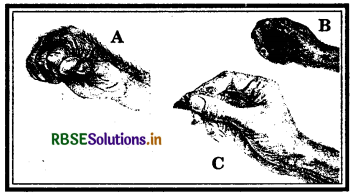
Answer:
(i) The evolution of the hand as depicted in each diagram :
(a) Diagram A shows the precision grip of the chimpanzee.
(b) Diagram B shows the power grip of the hominid.
(c) Diagram C shows the precision grip of the human hand.
The development of the power grip probably preceded the precision grip.
(ii) In the first place, man got himself distinguished from other animals and his arms also became free. He could hold things in his hands and by he became an artisan.
Secondly, his erect position made him see objects from far off distances.
Thirdly, he was now in a better position to protect himself from his enemies. He invented tools and made great achievements as compared to animals due to his erect posture.
Question 26.
Look at these four skulls of human beings marked as A, B, C and D. Find out/identify to which Homo-spices it belongs ?
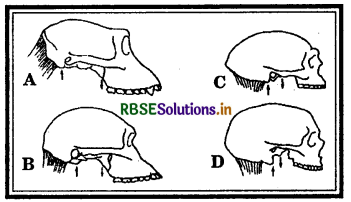
Answer:
Skull A belongs to an ape.
Skull B belongs to a species known as Australopithecus.
Skull C belongs to a species known as Homo erectus.
Skull D belongs to a species known as Homo sapiens to which all present-day human beings belong.
The main differences have been noticed in the brain case, jaws and teeth.
Long Answer Type Questions:
Question 1.
How can you justify that with the onset of a phase of glaciation (ice age), there were major changes in climate and vegetation ? Mention the species that were better adapted to the drier conditions.
Answer:
Around 2.5 mya, with the onset of the glaciation phase (an Ice Age), the large part of the earth was covered with snow. As a result many changes occurred in climatic conditions and vegetation cover. With the reduction in temperature and rainfall, grassland areas expanded at the expense of forests, leading to the gradual extinction of the early form of Australopithecus and the replacement by species that were better adapted to the drier conditions. Among them were the earliest representatives of the genus Homo.
Hominids, a family of Hominoids include all forms of human beings. The distinctive characteristics of Hominids include large brain size, upright posture and specialisation of the hand.During this age under the influence of climatic changes, Hominids further sub-divided into two branches known as Australopithecus and Homo. The major difference between two is brain size, jaws and teeth.

Question 2.
Describe some facts regarding the ways of obtaining food during early historic period.
Answer:
During the early historic period the early humans would have obtained food through a number of ways, such as gathering, hunting, scavenging and fishing, etc.
• Gathering involves collection of plant foods such as seeds, nuts, berries, fruits and tubers. It was practised collectively. We get a fair amount of fossil bones, fossilised plants’ remains, etc., to provide- an ample example of gathering.
• The only way of getting information about plant intake would be the plants’ remains which were accidentally burnt. Archaeologists have not found much evidence of carbonised seeds for the very early period.
• It is suggested that the early human scavenged for meat and marrow form of carcases of animals had died naturally or had been killed by other predators.
• It is also equally possible that small mammals such as rodents, birds (and their eggs), reptiles, insects (such as termites) were also eaten by early man (Hominids).
• The earliest clear evidence for the deliberate planned hunting and butchery of large mammals comes from two sites:
(i) Boxgrave in South England.
(ii) Schoningen in Germany.
• Fishing is also important as evident from the discovery of fish bones at several places.
Question 3.
Complete a timeline providing clues of the following :
Beginning of earth, appearance of mammals and man, beginning of recorded history, invention of fire and beginning of settled life.
Answer:
Beginning of earth, appearance of mammals and man and Beginning of Recorded history : The age of the earth is now calculated to be about 4500 million years. If these years are represented by a road of 100 kilometres and we walk along it, we would not come across any life, even vegetation, at all for the first half of our journey. We would have to continue up to the 88th kilometre before even simple invertebrates, such as worms and jelly fish, would being to appear in the sea.
At the 93rd kilometre certain organisms would leave the sea to live on land, but the mammals would not come on the scene still the 98th kilometre is reached. The entire period of man’s physical evolution would not take more than the last 20 meters of our journey. And the age of written history and civilization would hardly take more than half of the very last stride ! There are many similarities in the physical structure and functions of lower animals and of man the highest products of the process of evolution. Man is both a mammal and a vertebrate.
Invention of Fire : Invention of fire was perhaps the most important achievement of man in the early stages of his development. It had a great significance in man’s development and his way of life. He learnt to warm his caves, get light and protect himself from the wild animals with its help. Later on, he began to eat cooked food.
Beginning of Agriculture and Settle Life: The beginning of agriculture and settled life in the Neolithic period led to many improvements in the community life of man. Now he had not to roam about in search of food. Because of farming he started the domestication of animals which gave him milk and curd etc. Time shows that farming made man a cultured being.
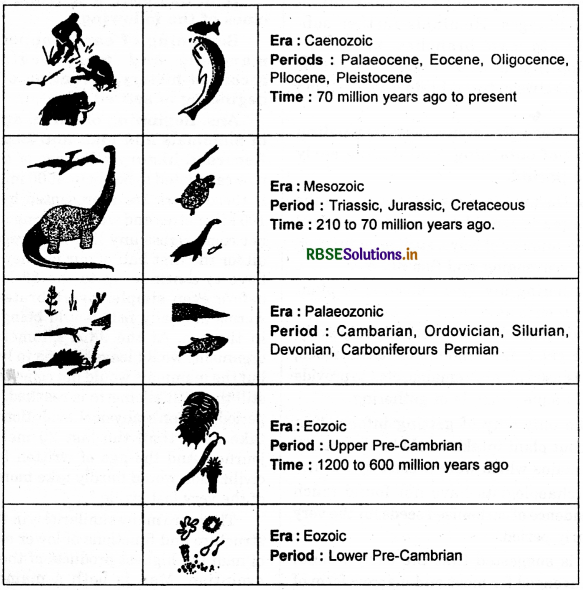
Question 4.
Write an account on cave painting.
Answer:
(i) Hundreds os paintings of animals have been discovered in the caves of Lascaus and Chauvet, both in France and Altamira in Spain. These include depictions of bisons, horses, lion, bear, owl etc.
(ii) Paintings of animals were associated with ritual and magic.
(iii) The act of painting could have been a ritual to ensure a successful hunt.
(iv) Paintings and engrairings served as the media for passing information from one generation to the next.
Question 5.
What do you know about the Hadza group ?
Answer:
They were a small group of hunters and gatherers living in the vicinity of Lake Eyasi, a salt, rift valley lake. Following were the main features of this, group :
(a) The main food of this group was vegetable food - roots, berries, the fruit of the baobab tree etc.
(b) Size and location of camps of Hadza people depended upon the availability of water. Their camps were widely dispersed in the wet season. But in dry season they were concentrated near the few available sources of water.
(c) In the dry season or in the year of drought there is never shortage of food to the Hadza people because food is abundantly available.
(d) Hadza people never assest their rights over land and its resources because they could live where they like and they may hunt animals.

Question 6.
What do you know about cave painting at Altamira. Write any five questions which can be raised regarding painting engraving discovered from Atlamira.
Answer:
Cave Paintings at Altamira : Altamira cave site is in Spain. The paintings engraved on the ceiling of the cave were first brought to the attention by a local landowner Marcelino Sanz de Sautuola and an amateur archaeologist, by his daughter Maria in November 1879.
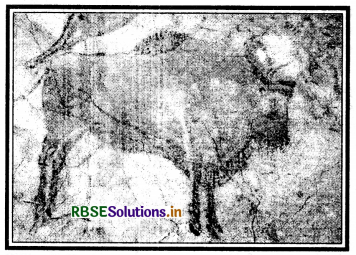
The girl noticed the paintings on the ceiling and told his father: ‘Look, Papa, oxen !’At first, her father just laughed, but soon he realised that some sort of paste rather than paint had been used for the paintings and become ‘so enthusiastic that he could hardly speak’. He published a booklet but for almost two decades later about his findings.
Several remains of artefacts have been discovered in the cave of Atlamira in Northern Spain, Dolni Vestonice, Predmosti, Lascaux cave and Grotte Chauvet in France dated back 50,000 years ago. Following questions can be raised about them are :
(i) Why do some areas of caves have paintings and not others ?
(ii) Why some animals were painted and not others ?
(iii) Why women depicted were only in groups ?
(iv) Why men were painted near animals but never women ?
(v) Why groups of animals were painted ?
Explanation : Paintings of animals associated with ritual and magic because of their importance in hunting. It might have possible that those cave were meeting places for small groups of people for group activities.
Question 7.
What should be the possible results of eliminating the use of fire and the wheel from modern man’s every day activities ?
Answer:
Possible results of eliminating the use of fire and the wheel from modern man’s everyday activities are as follow :
(i) If we eliminate their use (i.e., use of fire and wheel) the man will retreat to old stone age of uncivilised existence.
(ii) These discoveries had assisted man’s march to the modern civilisation. Without these discoveries all these progress will stop.
(iii) Man’s life in the all spheres like social, political, economic will be suffered a lot.
(iv) No cooked food and modem means of transport will be available.
(v) All kinds of machines without the use of wheel will come to a standstill.
Question 8.
Do you think that it would be possible to live anywhere today exactly as the Stone Age man lived ? Why or why not ?
Answer:
It would and would not be possible to live anywhere today exactly as the Stone Age man lived.
(i) Look at the present state of civilisation which is at highest point of achievements, it seems untenable that man would be able to live like his Stone Age predecessor.
(ii) This point of view of my not be fully correct as even today there are regions where man still lives an uncivilized existence. Such regions are extensively found in the African continent.
In these regions people still cover themselves with barks and leaves or skins of animals. They are still ignorant about the methods of weaving and spinning of cloth etc.
In these regions people still gather food by hunting animals, catching fish and gathering fruits and roots.
Due to the lack of education and prevalence of ignorance, people in these regions still believe in magic and witchcraft and are quite ignorant about the present; civilization.
Source Based Questions
1. Read the following passage carefully and answer that questions that follow :
The Hadza
‘The Hadza are a small group of hunters and gatherers, living in the vicinity of Lake Eyasi, a salt, rift-valley lake...The country of the eastern Hadza, dry, rocky savanna, dominated by thorn scrub and acacia trees...is rich in wild foods. Animals are exceptionally numerous and were certainly commoner at the beginning of the century. Elephant, rhinoceros, buffalo, giraffe, zebra, waterbuck, gazelle, warthog, baboon, lion, leopard, and hyena are all common, as are smaller animals such as porcupine, hare, jackal, tortoise and many others.

All of these animals, apart from the elephant, are hunted and eaten by the Hadza. The amount of meat that could be regularly eaten without endangering the future of the game is probably greater than anywhere else in the world where hunters and gatherers live or have lived in the recent past. Vegetable food-roots, berries, the fruit of the baobab free, etc.-though not often obvious to the casual observer, is always abundant even at the height of the dry season in a year
of drought. The type of vegetable food available is different in the six-month wet season from the dry season but there is no ' period of shortage. The honey and grubs of seven species of wild bee are eaten; supplies of these vary from season to season and from year to year. Sources of water are widely distributed I over the country in the wet season but are very few in the dry season. The Hadza consider that about 5-6 kilometres is the maximum distance over which water can reasonably be carried and camps are normally sited within a kilometre of a water course.
Part of the country consists of open grass ’ plains but the Hadza never build camps there. Camps are invariably sited among trees or rocks and, by preference, among both.The eastern Hadza assert no rights over s land and its resources. Any individual may live wherever he likes and may hunt animals, collect roots, berries, and honey and draw , water anywhere in Hadza country without any sort of restriction...
In spite of the exceptional numbers of game animals in their area, the Hadza rely mainly on wild vegetable matter for their food. Probably as much as 80 per cent of their food by weight is vegetable, while meat and honey together account for the remaining 20 per cent. Camps are commonly small and widely dispersed in the wet season, large and concentrated near the few available sources of water in the dry season. There is never any shortage of food even in the time of drought.’ Written in 1960 by James Wood-burn, an anthropologist.
Questions :
(i) What kind of life the people of Hadza lived ?
(iii) Why is there never any shortage of food even in the time of drought in Hadza ?
Answer:
(i) They lived in small groups and were hunters and gatherers.
(ii) Vegetable, food, roots, berries, the fruit of the baobab tree, etc. is always abundant even at the height of the dry season in a year of drought. The type of vegetable food available is different in the six-month wet season from the dry season but there is no period of shortage. The honey and grubs of seven species of wild bee are eaten; supplies of these vary from season to season and from year to year.So, there is never any shortage of food even in the time of drought.

Map Questions
Question 1.
On the map of Africa mark and locate Chad, Sudan, Ethopia, Diekelders, Red Sea. Tanzania, Kenya, Tanazua, and Uganda.
Answer:
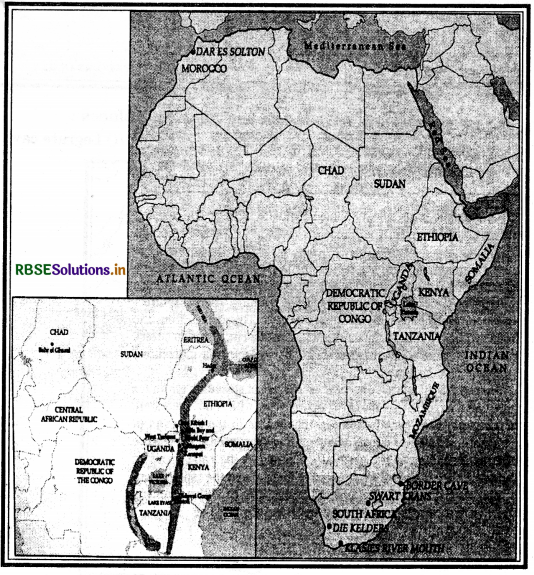
Question 2.
On the map of Europe locate the sites from where fish bones have been found.
Answer:

Question 3.
On the given map of Africa olark the following places :
(i) Altamira cave
(ii) Neander Valley
(iii) Legrate cave
Answer:
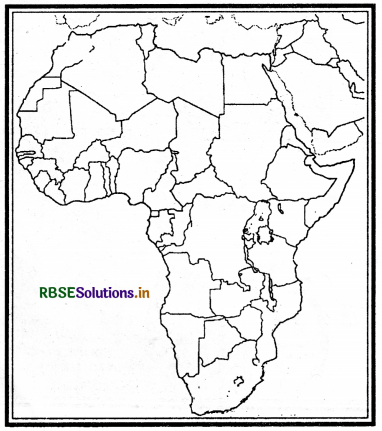

Choose the Correct Option:
Question 1.
When did the Primate mammals came into beings ?
(a) 36-24 mya
(b) 06-04 mya
(c) 19-14 mya
(d) 10-08 mya
Answer:
(a) 36-24 mya.
Question 2.
Who provide significant information about the Hadza ?
(a) James Wood
(b) James William
(c) James Woodbum
(d) James John Raman
Answer:
(c) James Woodbum.
Question 3.
When was we got first time information about the Hadza ?
(a) 1965
(b) 1960
(c) 1970
(d) 1974
Answer:
(b) 1960.
Question 4.
Who is the author of the book “On the Origin of Species” ?
(а) Charles Mcmillion
(b) Charles Mayur
(c) Charles Darwin
(d) Ramsay Thomas
Answer:
(c) Charles Darwin.
Question 5.
Where do earliest evidence of Hominoids comes from ?
(a) Laetoli and Hadar
(b) Spain
(c) France
(d) Africa
Answer:
(a) Laetoli and Hadar.
Question 6.
Where are Altamira caves ?
(a) France
(b) Spain
(c) Africa
(d) South America
Answer:
(b) Spain.

Question 7.
When did Homo came into existence?
(а) 1.6 mya
(b) 19 mya
(c) 2.5 mya
(d) 2.9 mya
(c) 2.5 mya.
Question 8.
Which is not correct about Homo ?
(a) The word Homo is taken from Latin
(b) It means human
(c) It includes both male and female
(d) It includes apes also
Answer:
(d) It includes apes also.
Question 9.
Which of early human beings know the art of walking while standing erect ?
(a) Homo erectus
(b) Homo
(c) Homo sapiens
(d) None of them
Answer:
(a) Homo erectus
Question 10.
Where do we get the evidence of use of fire ?
(a) Mod Jokerto
(b) Kenya
(c) Java
(d) Sangiram
Answer:
(b) Kenya
Question 11.
Which of these are famous Homo sapiens places ?
(a) Border Cave
(b) Omo Kibish
(c) Dar-es-Solton
(d) All of these
Answer:
(d) All of these.
Question 12.
Which of the following was not a way of obtaining food for early human ?
(a) Gathering
(b) Cooking
(c) Hunting
(d) Fishing
Answer:
(b) Cooking.

Question 13.
Lazaret caves are in ..............
(a) Java
(b) France
(c) Spain
(d) Africa
Answer:
(b) France.
Question 14.
Primates did not include ................
(a) Apes
(b) Human
(c) Monkey
(d) Donkey
Answer:
(d) Donkey.
Question 15.
Primates existed about ................
(a) 16-13 mya
(b) 36-24 mya
(c) 2.2 mya
(d) 04 mya
Answer:
(6) 36-24 mya.
Question 16.
When was earliest evidences of Australopithecus discovered ?
(a) 1976
(b) 1989
(c) 1959
(d) 1967
Answer:
(c) 1959.
Question 17.
Man invented sewing needle about:
(a) 5000 years ago
(b) 15000 years ago
(c) 21,000 years ago
(d) 6 mya-3.5 mya
Answer:
(c) 21,000 years ago.
Question 18.
Which is not a feature of Australopithecus ?
(а) They had heavier jaws
(b) They had bigger teeth
(c) They spent most of their times on trees
(d) They live in cave permanently
Answer:
(d) They live in cave permanently.

Question 19.
Which were the features of Neanderthals ?
(i) They have a bigger brain
(ii) They were short in height
(iii) The had much larger head
(iv) They have much hairy growth on the body:
(a) (i) and (iv)
(b) (ii) and (iii)
(c) (i) and (iii)
(d) (ii) and (iv)
Answer:
(b) (ii) and (iii).

- RBSE Class 11 History Important Questions Chapter 10 Displacing Indigenous Peoples
- RBSE Class 11 History Important Questions Chapter 2 लेखन कला और शहरी जीवन
- RBSE Class 11 History Important Questions Chapter 7 Changing Cultural Traditions
- RBSE Class 11 History Important Questions Chapter 6 तीन वर्ग
- RBSE Class 11 History Important Questions Chapter 6 The Three Orders
- RBSE Class 11 History Important Questions Chapter 3 तीन महाद्वीपों में फैला हुआ साम्राज्य
- RBSE Class 11 History Important Questions Chapter 3 An Empire Across Three Continents
- RBSE Solutions for Class 11 History Chapter 1 From the Beginning of Time
- RBSE Class 11 History Important Questions Chapter 11 Paths to Modernisation
- RBSE Class 11 History Important Questions in Hindi & English Medium
- RBSE Class 11 History Important Questions Chapter 9 The Industrial Revolution